Summoned to Court
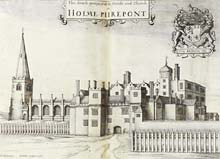
Holme Pierrepont Hall and Church, from Dr Thoroton's Antiquities of Nottinghamshire (1677) From East Midlands Spec. Coll. Not 1.D14.THO
Although the 17th-century Archdeaconry court was popularly known as 'the Bawdy Court', its efforts to control sexual activity outside marriage accounted for only part of its business.
The presentments made at Easter 1618 illustrated a typical range of concerns. Most of the forty-one distinct types of offence were commonplace charges, such as non-attendance at church, not paying church duties, or sexual misdemeanours, but some were more unusual.
In Holme Pierrepont, Mrs Rossell's grave lay uncovered by a stone, because 'the way is very foul'. Her executor was allowed until Trinity Sunday to rectify the fault.
The attractions of the alehouse often tempted people out of church, and George Pacie of Girton was presented for keeping his alehouse open during divine service.
It was not only lay people who enjoyed a drink: William Saxton, the vicar of Gringley-on-the-Hill, was presented by his churchwardens for being a 'haunter of alehouses'.
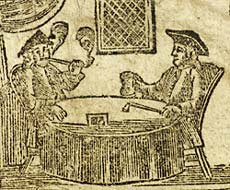
Illustration from the ballad 'Nottingham Ale' (19th century) from Spec. Coll. Oversize Ballads I : PR 1181.B2
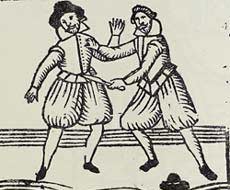
Man being stabbed (17th century) from the Euing Collection of English Broadside Ballads held at the Department of Special Collections, Glasgow University Library
Arguing and fighting in the church or churchyard was occasionally reported, with the clergy or churchwardens sometimes the targets of violence. However, in 1618 the parson of Costock allegedly struck the clerk's boy in the church, and the curate of Cotham, Roger Lodes, drew his dagger in the churchyard against Thomas Atkinson!
At different times the court focused on different types of offence, sometimes following a national lead.
William Laud (1573-1645), Archbishop of Canterbury, tried to enforce uniformity in church furnishing, especially with regard to altars and communion rails. Puritan opposition to their introduction in the late 1630s brought many individuals before the court.
- 1587-1599 Not repairing the church building
- 1600-1609 Not receiving holy communion
- 1610-1619 Not receiving holy communion
- 1620-1629 Sexual relationships before marriage
- 1630-1639 Sexual relationships before marriage
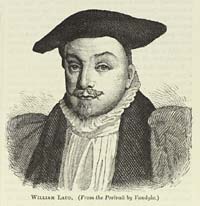
William Laud, Archbishop of Canterbury, from Henry Morley (ed.), Illustrations of English Religion (London : Cassell and Co. Ltd, 1884) from Spec. Coll., Queen Elizabeth's School Library
As more people turned from the Anglican church to dissenting communities, opposition to the church courts increased. In 1643 the Nottingham Archdeaconry court ceased to sit, and it was abolished altogether during the Commonwealth period.
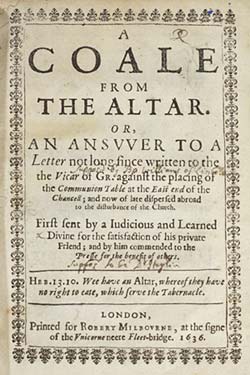
Pamphlet relating to communion rails (1636) from Spec Coll pamphlet BV 195.H4
Next: Decline and Abolition